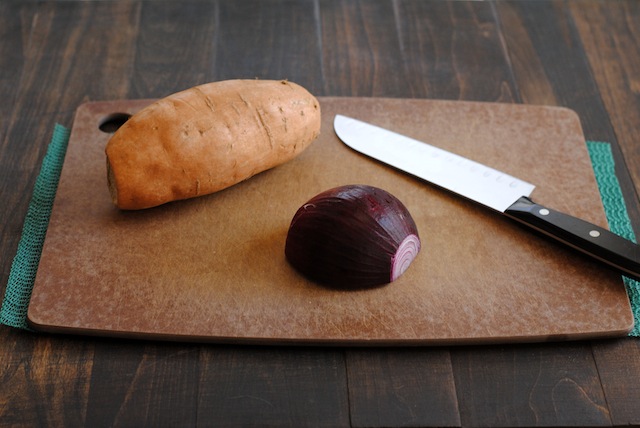Culinary School Lesson: Cutting Board Safety
In my “What I Learned in Culinary School” series, I’ll be sharing tips and tricks that I learned from two years of working with some of the country’s best chefs.
This will include big things like learning to work efficiently, and small things like how to cook bacon perfectly. All of them will be applicable to your home kitchen, making you a faster, better, and more confident cook.
This will include big things like learning to work efficiently, and small things like how to cook bacon perfectly. All of them will be applicable to your home kitchen, making you a faster, better, and more confident cook.
Let’s talk about kitchen safety. It may not be the sexiest topic, but it’s a necessity. One of the most dangerous things possible in a kitchen is a slippery cutting board.
You know the one. You’re trying to dice some carrots or make roasted acorn squash slices and slippppp – there it goes. Your hand and your knife will probably follow this cutting board around the counter while it takes a tour of the area.
Now, I just had my knives sharpened at the farmer’s market last weekend. The edges are razor sharp, making it even more imperative that my cutting board not slide around. I quite like all 10 of my fingers, covered in burns and scars though they may be.
There’s a couple of solutions to slippery cutting boards. One that a lot of home cooks like is a cutting board with nonslip grips built right into it, like this. However, I’m partial to my trusty Epicurean cutting boards. I use a simple hack to make these nonstick: a cheap roll of non-stick mat material.


Square pieces of this material were issued to the culinary students before we even took out our knives. I like it because it’s cheap, it’s easy to find at craft and home improvement stores, it’s nearly impossible to destroy (I’m still using my original pieces from three years ago!), and you can even throw it in the dishwasher.
Oh, and your cutting board will not budge when it’s resting on this stuff. Don’t want to buy a roll of this? Grab a tea towel or washcloth and do the same thing:


The towel method works best if either the towel is slightly damp, or the counter is slightly damp before you lay down the dry towel.
And guess what? In a pinch, you can use damp paper towel, too. Whatever method works for you – give it a try! Once you get used to confidently slicing and dicing on a stable surface, you’ll never go back to chasing your board around the counter again.

